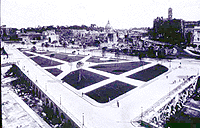Forum News
This chapter is periodically updated with the
latest news, unpublished, on the findings and work provided by the work site Staff of the
Imperial Forums.
APRIL 1999
 Since April 21st,
1998, excavation research has progressed- in the Forum of Trajan they have been focusing
on work in the area between Via Alessandrina and Via dei Fori Imperiali. This was the
original area of the piazza and southern wall of the Since April 21st,
1998, excavation research has progressed- in the Forum of Trajan they have been focusing
on work in the area between Via Alessandrina and Via dei Fori Imperiali. This was the
original area of the piazza and southern wall of the  the Forum of Trajan, transformed into
public landscaping in 1932. the Forum of Trajan, transformed into
public landscaping in 1932.
They have already recovered structures in the Alessandrino quarter which was destroyed
during the years 1924-1932. Particularly visible today are three blocks almost completed
intersected by two streets, apparently the old roads of the quarter: Via del Priorato and
Via Dei Carbonari. Here there is an intermediate block as well as two other blocks of
buildings arranged along the north and east edge of the excavation.
While the two blocks at the extreme southern and northern sectors reveal homes and
structures from a modern epoch, the intermediate block has revealed the presence of an
interior hall (about 10x30 meters) built with tufa on the inside and brick on the outside,
dating it between the end of the XII century to the first half of the XIII century.
 This medieval structure
occupies the northern limits of the area. This area is where the 1600's church of
Sant'Urbano was inserted and destroyed during the 1930's with the annexed convent of the
Sisters of Cappuccine. This medieval structure
occupies the northern limits of the area. This area is where the 1600's church of
Sant'Urbano was inserted and destroyed during the 1930's with the annexed convent of the
Sisters of Cappuccine.
One of the objectives trying to be reached in these days is the identification of the
original function of this medieval structure. In the past, Ceschi interpreted it as a
hospital belonging to the Priorate of Cavalieri from the order of Malta and a member of
the noble "domus" Bianco family.
 Some sectors have already reached down to
the floor of the Forum, where imprints for marble slabs of pavement are evident. The
antique floor is located less than one meter under the convent floor. Some sectors have already reached down to
the floor of the Forum, where imprints for marble slabs of pavement are evident. The
antique floor is located less than one meter under the convent floor.
In one area, used as a storage space after 1870, they have been able to reach the level of
the Forum under the convent's cellar floor. An excavated area here pointed out the
probable use of a garden or threshing floor from where architectural fragments were buried
together with a giant statue of a Dacian prisoner.
 On the bottom of
this stratification are a series of strong muddy layers that indicate the probable
presence of a swamp, and a sign that the Roman monuments were abandoned. Also here, as in
Caesar's Forum, certain tombs indicate that the Temple of Peace was transformed into a
sepulchral area during the first years of the early medieval period (VI-VII A.D.). Just
now, they have recovered structures related to the antique era marked by the Forma
Urbis in the excavation area between Via Alessandrina and Via dei Fori Imperiali.
These pieces have been interpreted differently: as garden-bed borders, as fountains, and
as bases of statues. On the bottom of
this stratification are a series of strong muddy layers that indicate the probable
presence of a swamp, and a sign that the Roman monuments were abandoned. Also here, as in
Caesar's Forum, certain tombs indicate that the Temple of Peace was transformed into a
sepulchral area during the first years of the early medieval period (VI-VII A.D.). Just
now, they have recovered structures related to the antique era marked by the Forma
Urbis in the excavation area between Via Alessandrina and Via dei Fori Imperiali.
These pieces have been interpreted differently: as garden-bed borders, as fountains, and
as bases of statues.
 However, they have seemed to
identify the revived structures as what were large enclosures for garden-beds since a
drainage pipe from the same enclosure was revived nearby. Only the continuation of
excavation can provide useful data that can resolve the functional mysteries of such
elements. Furthermore, it provides us with information on both the organization and
architectural structure of the Templum Pacis- actually one of the most enigmatic
monuments of antiquity of which little is known. However, they have seemed to
identify the revived structures as what were large enclosures for garden-beds since a
drainage pipe from the same enclosure was revived nearby. Only the continuation of
excavation can provide useful data that can resolve the functional mysteries of such
elements. Furthermore, it provides us with information on both the organization and
architectural structure of the Templum Pacis- actually one of the most enigmatic
monuments of antiquity of which little is known.
Enter into the chapters that describe work in
progress:
> Presentation
of the operation
> Imperial Forum area
> Methodology of the
archeological excavation
> The staff engaged in
recovery
In the other chapters you can find the history of
Rome, the life and habits of the Antique Romans, interesting phrases from the Latin
language, and a quiz to test yourself on your knowledge. Select a chapter among the four
titles in the black column on the right.
|



